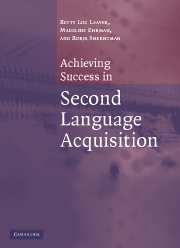Book contents
- Frontmatter
- Contents
- Notes on authors
- Acknowledgments
- Note to the reader
- Part I Learning
- Part II Language
- Part III Independence
- Epilogue: from here to there: attaining near-native proficiency
- Appendix A Answers to “practicing what you have learned”
- Appendix B Learning strategies taxonomies
- References
- Index
Appendix B - Learning strategies taxonomies
Published online by Cambridge University Press: 12 November 2009
- Frontmatter
- Contents
- Notes on authors
- Acknowledgments
- Note to the reader
- Part I Learning
- Part II Language
- Part III Independence
- Epilogue: from here to there: attaining near-native proficiency
- Appendix A Answers to “practicing what you have learned”
- Appendix B Learning strategies taxonomies
- References
- Index
Summary
Poulisse taxonomy
Nanda Poulisse (1990) suggested a taxonomy for compensation strategies in French as a foreign language. These were used by Poulisse and her colleagues to research how students compensate when they find themselves in conversations that are above their heads. The result was that four kinds of compensation strategies are used:
holistic (using words that share the concept);
analytic (e.g. describing features of the concept);
transfer; and
appeal for assistance.
Tarone taxonomy
Elaine Tarone (1980) has suggested five categories in her taxonomy:
avoidance (topic avoidance and memory abandonment);
paraphrase (approximation, word coinage, and circumlocution);
conscious transfer (literal translation and language switch – this one might get you into more trouble than it gets you out of);
appeal for assistance, and
mime (use of nonverbal language).
For the most part, she is referring to speaking strategies used for communication. See chapter 10 for a detailed description of managing communication situations.
Oxford taxonomy
One of the most widely used taxonomies was suggested by Oxford (1990). In this taxonomy, she breaks learning strategies into six kinds:
cognitive, such as analysis, applying background knowledge, and prediction, among others;
metacognitive, such as self-evaluation of progress, planning language study, and reviewing, among others;
affective, such as keeping diaries and positive self-talk, among others;
social, such as joining a language table or asking questions, among others;
compensation, such as paraphrasing, guessing from context, and circumlocution, among others; and
memory, such as using mnemonics and keywords, among others.
The Strategy Inventory for Language Learning (SILL) is available in a number of languages for determining your strategy usage.
- Type
- Chapter
- Information
- Achieving Success in Second Language Acquisition , pp. 246 - 247Publisher: Cambridge University PressPrint publication year: 2005



